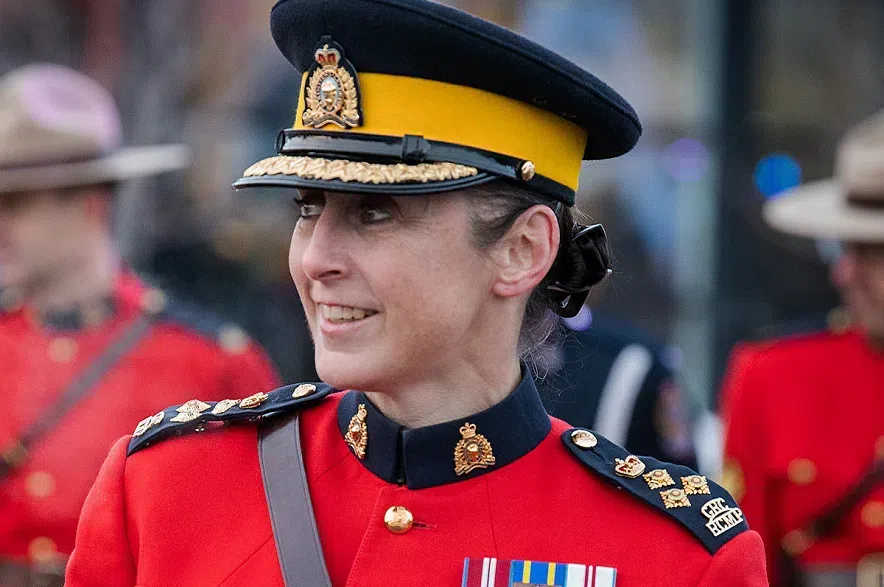The top Mountie in Saskatchewan joined the Evan Bray Show last week for an interview covering everything from homicide statistics to human trafficking and automated licence plate readers.
Assistant commissioner Rhonda Blackmore said the number of homicides in Saskatchewan RCMP jurisdiction between January and March fell from 15 in 2024 to just seven this year. Blackmore also touched on the recommendations made after the 2022 mass murder on the James Smith Cree Nation, homelessness around Saskatchewan, and the impact the weather can have on crime rates.
Listen to the full interview here, or read the transcript below:
The following questions and answers have been edited for length and clarity.
EVAN BRAY: I remember from my policing days that warm, beautiful weather also can sometimes bring about a different aspect of busy for police, the weather can play a difference in things, can’t it?
RHONDA BLACKMORE: Oh absolutely. Last week was National Telecommunicators Week, and I was speaking with my operational communication center personnel, and they described it as July in April because they’ve been so busy lately.
We have different types of crime in the middle of winter than we do in the middle of summer. But the trend lines are there. Let’s talk about that. Where are things at? What are crime stats looking like (and) some of the pressures, some of the trends you’re seeing.
When we look at the first three months, like January to March year over year, we are seeing, actually, some – I would call them – slight decreases. You know, property offenses down maybe four per cent. Those violent crimes, we have seen a bit of a decrease. In some areas they’re holding fairly steady (and) some areas are up. Some incidents like uttering threats and some forcible confinement, we’ve seen some increases, but our homicide numbers have actually dropped from last year to this year. Last year, between January and March we had 15, and January to March this year we’re at seven, although the RCMP does provide our major crimes investigations on homicides to other police agencies, so there’s been 12 total that we’ve investigated, but only seven of those have been in RCMP jurisdiction.
There is a frustration in rural Saskatchewan about thefts and about those types of property crimes. Is there a worry when you see a decrease that it’s a decrease in people reporting it?
Always. We want to make sure that people are reporting it, and we hope they are. These are January to March, right? So you look at January of last year – you just mentioned the weather – much milder January to March. This year, much colder. People tend to stay in, including the criminals. They don’t really like being out in bad weather. So there’s lots of factors that could factor into that, and we always have to be careful with percentage changes, right? They they can sound really big, but if you had one incident and then you have two, that’s a 100 per cent increase, but maybe it’s still not a crisis situation, right?
We’ve seen a lot of social issues manifest themselves in our big communities, Saskatoon and Regina, certainly. We talk about it all the time: homelessness, mental health, drugs, suicides. We’ve talked about that before when we’ve had you on the program, but I’m curious, what does that look like in the communities that the RCMP serves? Let’s take something like homelessness. Is it a big issue?
I think it is a big issue. Not to the same extent, but you have to remember, in a lot of our communities, they’re remote and they don’t have access to the same services that might provide some of those assistance pieces to that homeless community. When you look at some of the services – I know you and I were at an event recognizing Mobile Crisis not that long ago – well, we don’t have those services in a lot of those remote communities, so it’s left to the police to try to deal with some of those issues that may have been handled by some support agencies that aren’t always available in some of our communities in RCMP jurisdiction.
Is there a case to be made that having those services in your communities might further reduce the crime and the police response that your members have to make?
I think it would reduce overall numbers. They’re not going out (and) stopping criminals, per se, but I do think if you can tackle some of those really complex issues of addictions and poverty that lead to homelessness and lead to drug trafficking – because the traffickers are going to the spots where they have a market for it, and unfortunately, people with addictions issues provide that market – if those root causes are not addressed, it continues to manifest itself in criminal behavior by others taking advantage of some of those vulnerable populations. So having some of those support services available to support those individuals, to maybe help them to find a way out of a life of addictions or whatever their issues may be, it certainly is a massive benefit to policing overall.
Just yesterday on the show, I had a guest who is from the States but has a company that specializes in using data analysis and artificial intelligence to do great work on human trafficking. It’s actually quite groundbreaking. While that conversation was happening, of course, we got texts in on the text line and many people are asking: how prevalent is human trafficking in Canada and in Saskatchewan? Can you answer that question?
I think one of the misconceptions – the biggest one that we see – is that it doesn’t happen here in Saskatchewan. And unfortunately, it does happen here. We’ve had a couple different incidents in the last year or so that our human trafficking or trafficking response teams were made aware of human trafficking situations. We had an individual who was charged last fall as a result of human trafficking. So I think we have to just not be naive that it is happening here. It may be not as prevalent as in some of the big cities, but it certainly is happening here.
You look for some of those signs that you could see: an individual who doesn’t have access to their ID or a passport or a cell phone, under the age of 18. About a year and a half ago, our members down by Swift Current stopped a speeding vehicle in the middle of the night, and it was an individual, 14 years old, driving the vehicle who had been trafficked out of Hamilton, Ontario. So we always have to remember, criminals travel, and they make their way across the country. So we have to be aware of that and be cautious and recognize that it’s happening here in Saskatchewan as well.
When we think of human trafficking, I think a lot of people assume the sex trade, and that is obviously a big part of it. But there’s lots of other ways, lots of other industries and in which workers are trafficked or illegally moved from province to province. Do you see that angle on it as well?
Absolutely. As a matter of fact, in the summer of 2023 we charged an individual for human trafficking, and that was a result of forced labour at several Saskatchewan restaurants. So as you say, it can have many different faces, and I think (we need) people being educated about it and making sure that they’re aware of it.
Next week there’s a great session called the Maddison Sessions that’s happening in Saskatoon, and that’s led by country singer Paul Brandt. He has an organization called Not In My City, and his Maddison Sessions are in honor of a young lady by the name of Maddison Fraser, who lost her life as a victim of human trafficking in Alberta. And our trafficking response team members will be there, and we’ll be presenting on what they’re seeing in the province here. So (it’s) a great opportunity to get the information out that we can’t turn a blind eye to it, and we can’t be naive to think that it’s not happening here, because it is.
We’re having these chats, and people will text in with different questions. I got one here, assistant commissioner Blackmore, from Tom in Saskatoon questioning about so you have those ALPRs, those automated license plate readers. Tom is wondering why won’t we place those strategically throughout the province on highways, overpasses, things like that, to help out in investigations? I think he’s thinking of the James Smith tragedy, vehicle theft, (and) Amber Alerts. So having those ALPRs throughout the province strategically on fixed locations, would that be helpful?
It would have limited helpfulness. I think our ALPRs are on all of our traffic vehicles, so technically they are placed throughout the province, because our traffic members travel throughout the province. The thing with placing them stationary is that you would need someone monitoring them to be of benefit, because you’re looking at a point in time, and we can’t retain that data indefinitely. There’s privacy implications. There’s only a limited amount of time that data can be retained, so it’s essentially a moment in time that’s telling you this vehicle was here at that time, and if there’s no person to respond to that… You know, there’s maybe potentially a benefit. I’d say it would be minimal, but overall, having our members, when a vehicle is noticed via those license plate readers, they see right away, “Oh, that’s an unlicensed driver.” “That’s an unregistered vehicle.” They get that information immediately and can pull that vehicle over. That’s the benefit to having it on those cars.
When I had you on in March, after we were done our discussion I noticed a text from David, and so I want to squeeze it in today. There were some recommendations that came out from that inquest that happened into the James Smith Cree Nation incident, and he wondered have you followed through with some of those recommendations? And I think specifically, he’s wanting to know if his anything has changed with the RCMP regarding warrant execution in the province.
Most definitely. And we followed through on every single recommendation. You’ll recall that there were some jury recommendations that came out of those inquests, but then there were also some specific recommendations from the coroner that followed up in addition to the jury recommendations, and we have followed up on each one of them. And to give you an example of some of the changes we’ve made with when it comes to warrants, we’ve really focused on trying to staff up some of those teams. Our warrant enforcement and suppression team has gone from a 35 per cent vacancy rate to now well below 20 per cent, so we’ve got more people out there working on executing those warrants.
There was a recommendation about our detachments getting a wider list of warrants, because normally they would just hold the warrant for their detachment area, individuals that they had dealt with are charged. Now, they get the list expanded for the whole province in RCMP jurisdiction, just to have better situational awareness so that they’re aware. All of those warrants are on CPIC, but they may be aware of an individual who may not have been run on our CPIC – our Canadian police Information Center. So when they run a name or a plate and there’s something attached to that, it comes up in that system. But just knowing someone’s in a community, they can be aware that there might be a warrant.
And then there was also a recommendation, with respect to our First Nation communities, that if an individual from that First Nation had a warrant out, and as long as it didn’t compromise in an ongoing investigation, that the First Nation leadership should be aware of the wanted status of that individual. So we now have the opportunity to provide the list of individuals who are on warrant status to our First Nation leadership and to our other communities. Our mayors, if they’re interested in receiving that information, our detachment commanders have that and can share that with them, because once an individual is charged, once they’re on warrant status, that’s public information. Better information sharing, so that they are aware of who in their community has warrants, because sometimes they’re another set of eyes or ears, and they hear things in the community that they can share with us, and hopefully lead us to apprehending that individual.











